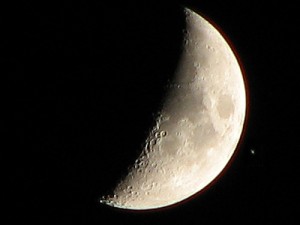August begins with three bright first-magnitude objects, two of them planets, clustered near to each other in the southwestern evening sky for several hours after sunset. The planets are Saturn at magnitude +0.8 and Mars at magnitude +1.1. On August 1st they will be seen within 10 degrees of each other (Saturn above), and through the month they will appear to draw closer together. Between August 7th and 20th they will be within a 5 degree circle which will also include 1st magnitude (+1.0) Spica, the brightest star in the zodiac constellation Virgo. In fact on the night of the 7th, the three will actually appear to form a neat triangle!
Spica is a blue giant star some 4 times hotter than our Sun and while it does not appear to move out of its constellation from year to year because of its great distance from us, the planet’s do make noticeable changes against the background stars in their orbits around the Sun. Saturn is far enough away so that its changes against the stars are much less than Mars which, moves a lot faster. So Mars will appear to pass between Spica and Saturn so that on the nights of August 13 and 14, the three will look like they are in a nearly straight line. A week later on the 21st, the three will form another triangle shape, with a lovely crescent Moon joining them, just a few degrees below the line.
We can distinguish the three objects from each other by color. Mars is reddish-orange, while Saturn is a more golden-yellow, and Spica looks bluish-white. It will be fun watching during the month as the 3 appear to move around each other in the southwest sky (roughly 9 to 11 pm).
In the morning sky look East for Jupiter, rising about 2 am and then visible until sunrise and bright (-2.2 magnitude), and sitting some 5 degrees above Aldebaran, the brightest star in Taurus. On the morning of the 11th, the waning crescent Moon will be near Jupiter.
Even brighter Venus at –4.6 magnitude rises about 3 hours before the Sun and the crescent Moon will be seen near it on the morning of August 13th.
August always brings the best meteor shower of the year into view —– the Perseids —- so named because the meteors appear to come from the sky which is occupied by the constellation Perseus. Some years we have to compete with a bright Moon blocking our view of some of the meteors, but this year a waning crescent Moon will offer little competition, and the peak night is on a weekend. The best night is August 11/12 —- Saturday night into Sunday morning. Best views which may be up to 60 to 80 meteors per hour occur from midnight to dawn looking in the northeast sky halfway up from the horizon. Perseid meteors are hunks of rock and dust debris from Comet 109P Swift-Tuttle. Each August Earth plows through its debris field and the particles incinerate in our atmosphere by friction.
One other item of note this month is that August this year has two Full Moons —- August 1st and August 31st. Though two Full Moons in a single month happen about once every three and a half years, it is infrequent enough to be one reason for the expression “once in a blue Moon.” No, the Moon does not really turn blue when it is full twice in a month, but Earth atmospheric conditions do make the Moon look blue sometimes; and that is even rarer.




